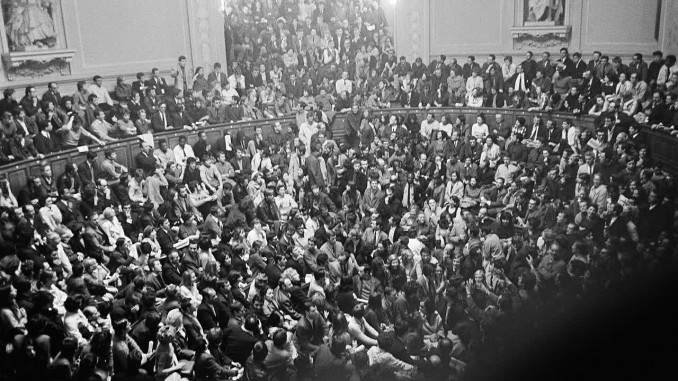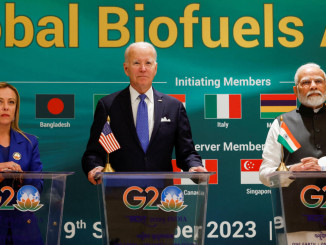
In March of 1968, the French student movement started in Nanterre, a suburb of Paris, at a brand new university campus. The campus had been built four years earlier on a sort of “no-man’s land,” next to an Algerian workers’ shantytown.
Some of these students were organized in mini-groups of the “extreme left.” These Trotskyists, anarchists, and Maoists mobilized against the U.S. war in Vietnam. Among them, six demonstrators were arrested on March 20 after a few stones were thrown against the windows of the American Express headquarters in Paris. To protest the arrests, the students of Nanterre occupied the administrative tower of the university. Following their expulsion and the closure of the campus, these students went to join those of the Sorbonne University located in the Latin Quarter of Paris. The student revolt had begun, confronting the police force of the French state, led then by President Charles de Gaulle.
From Student Barricades to the General Strike
In May of ’68, students occupied the Sorbonne University. The government sent police to expel them and more than 500 people were arrested. Two thousand young people swarmed the streets of the Latin Quarter in response, clashing with the police and shouting the slogan “Libérez nos camarades!” (“Free our comrades!”) Then high school students joined the protests and there were more street clashes with the police. The student movement grew following what was later called the “nuit des barricades” (“night of the barricades”) on May 10 and 11. The next morning 400 more people were arrested. The public was outraged at the extent of the repression.
Public opinion quickly shifted in favor of the students. The teachers’ unions and other workers’ unions, siding with the main student union, called for a demonstration to take place on Monday, May 13, to protest the repression. To everyone’s surprise, an immense crowd estimated at 500,000 people overran the streets of Paris. Huge demonstrations also took place in cities all across the country. Among the most common slogans was: “Ten Years is Enough,” referring to the fact that de Gaulle had been in power since 1958. The CGT (General Confederation of Labor), the most influential union at the time, was linked to the French Communist Party. Up to that point, the CGT had not sided with the movement and had denounced the protesters as “leftists.” When the CGT called for a one-day strike on May 13, they intended it to be a purely symbolic action and hoped to bring the confrontations to an end. History decided otherwise.
The next day, the workers of Sud-Aviation in Brittany went on strike and occupied their factory, thanks to the initiative of a Trotskyist activist from the Internationalist Workers Party. They formed a strike committee despite fierce opposition from the CGT militants. The strike expanded quickly to the factories of Renault Cléon in Normandy. Step by step, the rank and file spread the movement to the whole country. It became a general strike with 7 million workers participating, and lasted for more than a month.
May 27: The “Grenelle Agreements”
The CGT wanted to put a quick end to the general strike, by negotiating with the employers and with the government. These negotiations took place at the Ministry of Labor in Grenelle Street in Paris. The result of these agreements was a general 10 percent increase in salaries and, more importantly, the creation of “Workplace Union Sections.” This was a gift to the union bureaucracies; it provided each union in the workplace with a hall, as well as paid hours for stewards who were chosen without even having to run for election.
The General Secretary of the CGT, George Séguy, thought that the deal was settled, and presented the outcome of the negotiations to a general assembly of 10,000 workers in Renault Billancourt. However, when he announced that the employers refused to pay for the strike days, a wave of indignation rose from the audience, and he was booed by thousands of workers. As a result, the CGT did not immediately give the order to go back to work, and instead encouraged workers to negotiate at the local level, company by company, in order to decide under what conditions work should be resumed. It meant that these negotiations took place in isolation from one another, without benefiting from the power of the general strike. The strikes continued for at least three more weeks, until the end of June. However, when they resumed work, many workers did so with a bitter taste in their mouth, and a feeling of anger.
De Gaulle Leaves… and then Returns
As to the government, it had a moment of panic after the rank and file refused the Grenelle Agreements. On May 29, President de Gaulle canceled the meeting of the Council of Ministers and secretly flew off to Baden-Baden in Germany. He sought advice from General Massu, who had commanded French forces in the Battle of Algiers in 1957. De Gaulle wanted to verify whether the French army would be ready to take action in case a revolutionary situation developed. When he returned to France on May 30, he was a reassured man. He announced the dissolution of Parliament, meaning that new legislative elections would take place. Meanwhile, a massive, reactionary demonstration was organized. Up to 300,000 members of the bourgeoisie and its middle-class supporters marched on the Champs-Elysées to support the government.
The workers were not impressed. Strikes went on until the end of June, despite the instructions of the CGT union to go back to work. The bonds between students and workers strengthened.
The French Communist Party was happy to take part in the electoral game, hoping this would restore order. Students and workers, on the other hand, preferred shouting “élections, piège à cons!” (Elections: a trap for fools!) And a trap for fools they were indeed. The reformist Communist and Socialist Parties didn’t win the elections, and ended up in the minority as the Gaullist Party got the majority of seats in the new Parliament.
What to Make of it All?
The government and the right did win the elections. But the whole political and social scene was altered. From the 1970s on, the number of workers’ strikes increased, especially fights for wage increases. Some strikes were led by revolutionaries and organized by democratic strike committees of rank-and-file workers. Over 50 years later, we can still learn much from this achievement.



